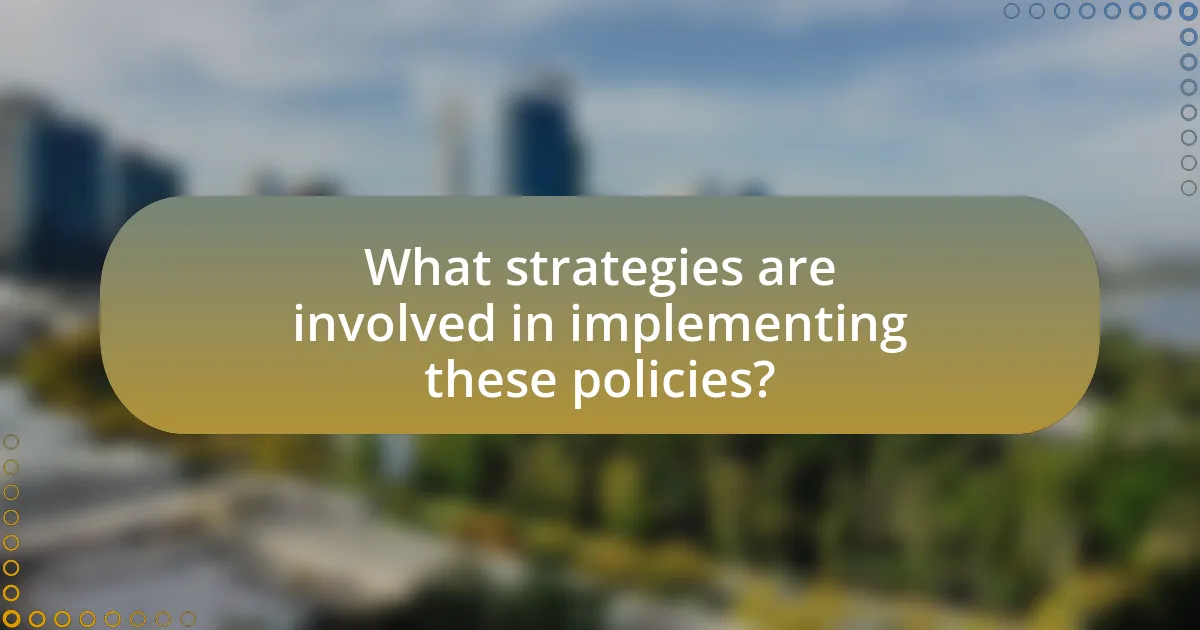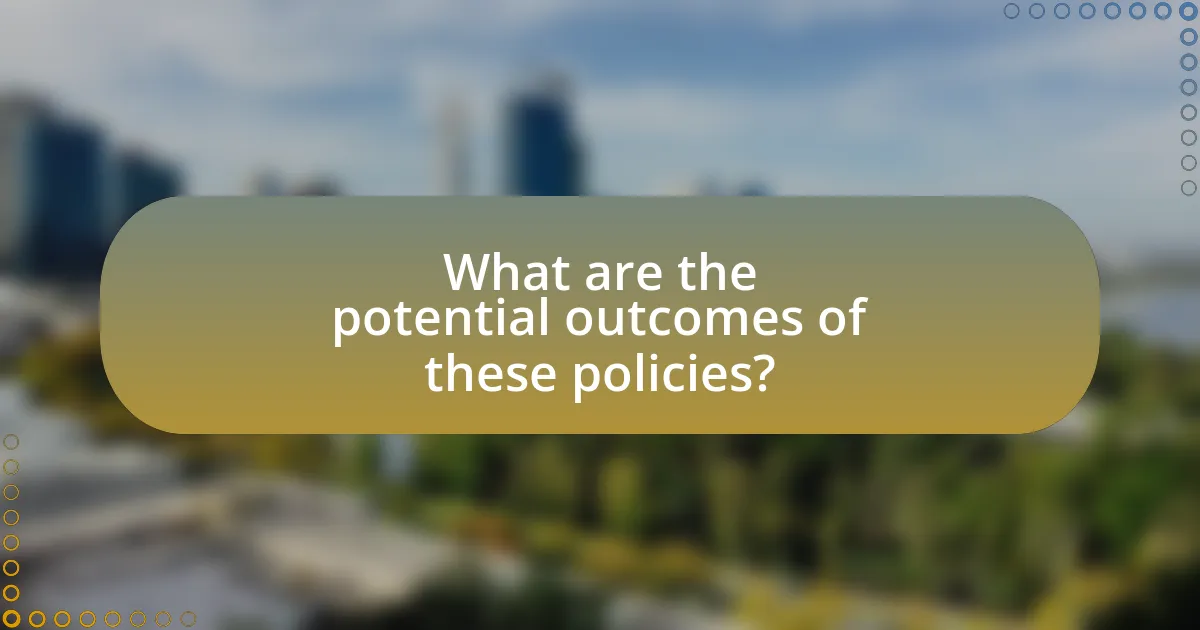Policies for enhancing urban resilience through ecological planning focus on integrating environmental considerations into urban development to mitigate risks from climate change, natural disasters, and urbanization. These policies promote sustainable land use, preserve green spaces, and enhance biodiversity through strategies like green infrastructure, which includes parks and green roofs. Key principles of ecological planning, such as sustainability, community involvement, and adaptive management, are essential for creating resilient urban environments. The article discusses the importance of urban resilience in the context of growing urban populations, the challenges cities face, and the role of stakeholders in policy implementation, while also highlighting successful initiatives and metrics for evaluating effectiveness.

What are Policies for Enhancing Urban Resilience through Ecological Planning?
Policies for enhancing urban resilience through ecological planning focus on integrating environmental considerations into urban development strategies. These policies aim to mitigate risks associated with climate change, natural disasters, and urbanization by promoting sustainable land use, preserving green spaces, and enhancing biodiversity. For instance, the implementation of green infrastructure, such as parks and green roofs, can reduce urban heat and manage stormwater effectively. Research indicates that cities adopting such policies experience improved air quality and reduced flooding, demonstrating their effectiveness in building resilience against environmental challenges.
How do these policies contribute to urban resilience?
Policies for enhancing urban resilience through ecological planning contribute by integrating sustainable practices that mitigate environmental risks and promote adaptive capacity. These policies often include green infrastructure initiatives, such as urban forests and permeable surfaces, which reduce flooding and improve air quality. For instance, cities implementing green roofs have reported a decrease in urban heat island effects and improved stormwater management, demonstrating the effectiveness of such policies in enhancing resilience. Additionally, policies that encourage biodiversity, such as habitat restoration, strengthen ecosystems, making urban areas more adaptable to climate change impacts.
What are the key principles of ecological planning in urban contexts?
The key principles of ecological planning in urban contexts include sustainability, integration of natural systems, community involvement, and adaptive management. Sustainability focuses on meeting present needs without compromising future generations, ensuring resource conservation and environmental protection. Integration of natural systems emphasizes the incorporation of green spaces, biodiversity, and ecosystem services into urban design, which enhances urban resilience against climate change impacts. Community involvement ensures that local populations participate in the planning process, fostering social equity and addressing specific community needs. Adaptive management involves continuously monitoring and adjusting strategies based on feedback and changing conditions, which is essential for effective long-term urban planning. These principles collectively contribute to creating resilient urban environments that can withstand ecological and social challenges.
How do these principles support resilience against climate change?
The principles of ecological planning support resilience against climate change by promoting sustainable land use, enhancing biodiversity, and improving ecosystem services. Sustainable land use minimizes environmental degradation, which helps cities adapt to climate impacts such as flooding and heatwaves. For instance, integrating green infrastructure, like parks and green roofs, can reduce urban heat and manage stormwater effectively. Enhancing biodiversity ensures that ecosystems remain robust and can recover from climate-related disturbances, as diverse ecosystems are more resilient to changes. Additionally, improved ecosystem services, such as carbon sequestration and air purification, directly mitigate climate change effects. Research indicates that cities implementing these principles experience lower vulnerability to climate impacts, demonstrating their effectiveness in fostering resilience.
Why is urban resilience important in today’s context?
Urban resilience is crucial in today’s context because it enables cities to effectively respond to and recover from various shocks and stresses, including climate change, natural disasters, and socio-economic challenges. As urban populations continue to grow, with projections indicating that by 2050, nearly 68% of the world’s population will live in urban areas, the need for resilient urban systems becomes increasingly urgent. Resilient cities can maintain essential functions during crises, thereby reducing vulnerability and enhancing the quality of life for residents. Furthermore, studies show that investments in urban resilience can yield significant economic benefits, with the Global Commission on Adaptation estimating that every dollar spent on resilience measures can generate up to $8 in economic returns.
What challenges do urban areas face that necessitate resilience policies?
Urban areas face significant challenges such as climate change, population growth, infrastructure strain, and social inequality, which necessitate resilience policies. Climate change leads to increased flooding, heatwaves, and extreme weather events, threatening urban infrastructure and public health. Rapid population growth results in overcrowding, increased demand for housing, and pressure on public services. Additionally, aging infrastructure often fails to meet the needs of growing populations, leading to service disruptions. Social inequality exacerbates vulnerabilities, as marginalized communities often lack resources to adapt to these challenges. These factors collectively highlight the urgent need for resilience policies to enhance urban sustainability and adaptability.
How does ecological planning address these challenges?
Ecological planning addresses urban resilience challenges by integrating ecological principles into land-use planning and development processes. This approach promotes sustainable resource management, enhances biodiversity, and mitigates environmental impacts, thereby improving the resilience of urban areas to climate change and other stressors. For instance, incorporating green infrastructure, such as parks and green roofs, can reduce urban heat islands and manage stormwater effectively, as evidenced by studies showing that cities with extensive green spaces experience lower temperatures and reduced flooding risks. Additionally, ecological planning encourages community engagement and adaptive management, ensuring that urban development aligns with ecological health and community needs, which is crucial for long-term sustainability.

What strategies are involved in implementing these policies?
Strategies involved in implementing policies for enhancing urban resilience through ecological planning include stakeholder engagement, integrated planning, and adaptive management. Stakeholder engagement ensures that community members, local governments, and organizations collaborate in the decision-making process, fostering a sense of ownership and accountability. Integrated planning combines ecological considerations with urban development, promoting sustainable land use and resource management. Adaptive management allows for flexibility in policy implementation, enabling adjustments based on monitoring and evaluation of outcomes. These strategies are supported by case studies demonstrating successful urban resilience initiatives, such as the use of green infrastructure in cities like New York and Copenhagen, which have shown significant improvements in flood management and biodiversity.
How can cities integrate ecological planning into their resilience strategies?
Cities can integrate ecological planning into their resilience strategies by incorporating green infrastructure, promoting biodiversity, and implementing sustainable land-use practices. Green infrastructure, such as parks, green roofs, and permeable pavements, enhances urban ecosystems while managing stormwater and reducing heat islands. For instance, a study by the National Oceanic and Atmospheric Administration (NOAA) found that cities with extensive green spaces can lower urban temperatures by up to 5 degrees Fahrenheit. Promoting biodiversity through urban wildlife corridors and native plant landscaping supports ecosystem health and resilience against climate change impacts. Additionally, sustainable land-use practices, such as mixed-use development and urban agriculture, can reduce resource consumption and enhance food security, as evidenced by the success of urban farming initiatives in cities like Detroit, which have revitalized neighborhoods and improved community resilience.
What role do stakeholders play in this integration?
Stakeholders play a crucial role in the integration of policies for enhancing urban resilience through ecological planning by providing diverse perspectives, resources, and expertise essential for effective decision-making. Their involvement ensures that the planning process is inclusive, addressing the needs and concerns of various community members, including government agencies, local businesses, non-profit organizations, and residents. For instance, studies have shown that stakeholder engagement leads to more sustainable outcomes, as it fosters collaboration and builds trust among participants, ultimately resulting in policies that are more likely to be accepted and implemented successfully.
How can public participation enhance policy effectiveness?
Public participation enhances policy effectiveness by incorporating diverse perspectives and local knowledge into the decision-making process. This inclusion leads to more informed policies that reflect the needs and values of the community, ultimately increasing public support and compliance. Research indicates that policies developed with public input are more likely to achieve their intended outcomes; for instance, a study by the International Association for Public Participation found that projects with stakeholder engagement had a 30% higher success rate compared to those without. By fostering collaboration between policymakers and the community, public participation not only improves the relevance of policies but also strengthens the social fabric, making communities more resilient to challenges.
What are the best practices for developing these policies?
The best practices for developing policies for enhancing urban resilience through ecological planning include stakeholder engagement, data-driven decision-making, and adaptive management. Stakeholder engagement ensures that diverse perspectives are considered, fostering community support and collaboration. Data-driven decision-making relies on empirical evidence and analysis to inform policy choices, enhancing their effectiveness. Adaptive management allows for flexibility and responsiveness to changing conditions, ensuring that policies remain relevant and effective over time. These practices are supported by case studies demonstrating successful urban resilience initiatives, such as the integration of green infrastructure in cities like New York and Copenhagen, which have shown significant improvements in flood management and biodiversity.
What examples exist of successful ecological planning initiatives?
Successful ecological planning initiatives include the Green City initiative in Freiburg, Germany, which integrates green spaces into urban design to enhance biodiversity and improve residents’ quality of life. This initiative has resulted in a 40% increase in green areas and a significant reduction in urban heat. Another example is the EcoDistricts program in Portland, Oregon, which promotes sustainable neighborhood development through community engagement and resource efficiency, leading to a 30% reduction in carbon emissions in participating districts. These initiatives demonstrate effective strategies for enhancing urban resilience through ecological planning.
How can lessons learned from these examples inform future policies?
Lessons learned from examples of ecological planning can significantly inform future policies by providing evidence-based strategies that enhance urban resilience. For instance, case studies demonstrating the effectiveness of green infrastructure in mitigating flooding highlight the need for policies that prioritize natural solutions over traditional engineering methods. Research shows that cities implementing green roofs and permeable pavements have reduced stormwater runoff by up to 50%, illustrating the tangible benefits of such approaches. Additionally, lessons from community engagement in ecological projects emphasize the importance of stakeholder involvement in policy formulation, leading to more sustainable and accepted outcomes. By integrating these insights into future policies, urban planners can create more adaptive and resilient urban environments.

What are the potential outcomes of these policies?
The potential outcomes of policies for enhancing urban resilience through ecological planning include improved environmental sustainability, increased community well-being, and reduced vulnerability to climate change impacts. These policies can lead to the restoration of natural ecosystems, which in turn enhances biodiversity and provides essential services such as clean air and water. For instance, cities that implement green infrastructure, like urban forests and green roofs, have reported a decrease in urban heat island effects and improved stormwater management, as evidenced by studies from the American Society of Civil Engineers. Additionally, these policies can foster social cohesion by engaging communities in planning processes, leading to stronger local networks and increased public health outcomes.
How do these policies impact urban ecosystems?
Policies for enhancing urban resilience through ecological planning significantly improve urban ecosystems by promoting biodiversity, reducing pollution, and enhancing green spaces. These policies often include regulations that protect natural habitats, incentivize the creation of urban green areas, and implement sustainable practices in urban development. For instance, cities that adopt policies encouraging green roofs and urban forests can see a reduction in urban heat islands and improved air quality, as evidenced by studies showing that urban greenery can lower temperatures by up to 5 degrees Celsius and improve air quality by filtering pollutants. Additionally, such policies foster community engagement and stewardship, leading to more sustainable urban environments.
What benefits do enhanced urban ecosystems provide to communities?
Enhanced urban ecosystems provide numerous benefits to communities, including improved air quality, increased biodiversity, and enhanced mental well-being. These ecosystems, such as green roofs, urban forests, and parks, contribute to cleaner air by filtering pollutants and producing oxygen, which is essential for public health. Studies indicate that urban greenery can reduce air pollution levels by up to 30%, significantly benefiting residents’ respiratory health. Additionally, enhanced biodiversity in urban areas supports various species, promoting ecological balance and resilience against environmental changes. Furthermore, access to green spaces has been linked to improved mental health outcomes, with research showing that individuals living near parks report lower stress levels and higher overall life satisfaction. These benefits collectively contribute to more sustainable and livable urban environments.
How can improved ecosystems contribute to public health and well-being?
Improved ecosystems contribute to public health and well-being by enhancing air and water quality, providing recreational spaces, and supporting biodiversity. Healthy ecosystems filter pollutants, which leads to cleaner air and water, reducing respiratory and waterborne diseases. For instance, urban green spaces have been shown to lower stress levels and promote physical activity, which are crucial for mental and physical health. Research indicates that access to nature can decrease anxiety and depression, as evidenced by a study published in the journal “Environmental Science & Technology,” which found that individuals living near green spaces reported better overall health. Additionally, diverse ecosystems support a variety of species that can contribute to food security and medicinal resources, further promoting community health.
What metrics can be used to evaluate the success of these policies?
Metrics that can be used to evaluate the success of policies for enhancing urban resilience through ecological planning include ecological health indicators, social equity measures, economic viability assessments, and community engagement levels. Ecological health indicators, such as biodiversity indices and water quality metrics, provide insights into the environmental impact of policies. Social equity measures assess the distribution of benefits and burdens among different demographic groups, ensuring that vulnerable populations are not disproportionately affected. Economic viability assessments evaluate the cost-effectiveness and long-term sustainability of implemented policies, often using metrics like return on investment (ROI) and job creation rates. Community engagement levels can be measured through participation rates in planning processes and feedback mechanisms, indicating the extent to which stakeholders are involved in decision-making. These metrics collectively offer a comprehensive framework for assessing the effectiveness of urban resilience policies.
What indicators are most relevant for assessing urban resilience?
The most relevant indicators for assessing urban resilience include infrastructure robustness, social equity, economic diversity, environmental sustainability, and governance effectiveness. Infrastructure robustness measures the ability of physical systems to withstand shocks, while social equity evaluates access to resources and opportunities across different demographics. Economic diversity assesses the range of economic activities that can buffer against downturns, and environmental sustainability examines the capacity of urban ecosystems to support human life and mitigate climate impacts. Governance effectiveness reflects the ability of institutions to respond to crises and engage communities in resilience planning. These indicators are essential as they provide a comprehensive framework for understanding how urban areas can adapt to and recover from various challenges, including natural disasters and socio-economic shifts.
How can cities measure the effectiveness of ecological planning initiatives?
Cities can measure the effectiveness of ecological planning initiatives through a combination of quantitative and qualitative metrics. Quantitative metrics include tracking changes in biodiversity, air and water quality, and urban heat island effects, often using pre- and post-implementation data to assess improvements. For instance, studies have shown that urban green spaces can reduce surface temperatures by up to 5 degrees Celsius, indicating a direct impact on urban heat management. Qualitative metrics involve community surveys and stakeholder feedback to gauge public perception and engagement with ecological initiatives. Research from the Urban Ecology Institute highlights that cities implementing ecological planning can see a 20% increase in community satisfaction related to green spaces, demonstrating the social benefits of such initiatives. By integrating these metrics, cities can effectively evaluate the success and areas for improvement in their ecological planning efforts.
What practical steps can cities take to enhance urban resilience through ecological planning?
Cities can enhance urban resilience through ecological planning by implementing green infrastructure, such as parks, green roofs, and permeable pavements, which help manage stormwater and reduce urban heat. These strategies not only mitigate flooding risks but also improve air quality and biodiversity. For instance, a study by the National Oceanic and Atmospheric Administration (NOAA) found that urban areas with increased green spaces can lower surface temperatures by up to 5 degrees Fahrenheit, significantly reducing heat-related health risks. Additionally, cities can adopt policies that promote sustainable land use, prioritize native vegetation, and integrate ecological considerations into zoning regulations, ensuring that urban development aligns with environmental sustainability goals.


